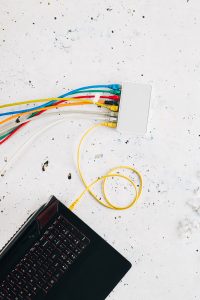Keyboard enthusiasts try various things to customize their keyboards. Some use different colored keycaps to make a unique color combination, some replace the switches to change how the keyboard feels, and others add extra keys for frequently used commands.
One popular customization is adding lubricant to the keyboard switches. This can be done to reduce key noise, make the keys feel smoother, or both. While adding lubricant can be a great way to improve your keyboard, it can also be a pain to remove if you ever want to go back to the stock feel or switch to a different type of lubricant.
Therefore, in this guide, we will show you how to remove lube from keyboard switches step by step. So, keep reading the article.
Removing lube from keyboard switches or not is a personal preference. Some people like the feeling of lubricated keys, while others prefer the stock feel. Here are a few reasons you might want to remove the lubricant from your switches:
1. You want to switch to a different type of lubricant
Most keyboard switches come pre-lubricated from the factory. However, you may not like the type of lubricant that was used. Or, you may want to try a different lubricant to see if you like it better. In either case, you’ll need to remove the existing lubricant before adding a new one.
2. You no longer want the keyboard to feel smoother
Lubricants make keyboard switches smooth by reducing the amount of friction between the keycap and switch. This allows for a smoother keystroke, which can be beneficial for people who type a lot or play games on their computers.
However, some people may prefer the feeling of non-lubricated switches. If the lubricant makes your keyboard feel too smooth, you need to remove it to regain the original feel.
3. The lubricant has dried out
Over time, the lubricant on your keyboard switches can dry out. This can make the keys feel scratchy and less smooth. As a result, you may experience more typos and miss-hits. If this happens, you’ll need to remove the old lubricant and add a new one to restore the smooth feeling.
Also Read: How to Get Hair Out of Keyboard?
Is it necessary to take the switches apart?
Cleaning a keyboard thoroughly while the switches are still intact is possible, but it will take more time. Also, you might be unable to reach some areas where the dirt has accumulated.
Therefore, we recommend taking the switches apart for a more accessible and more effective cleaning of the switches. Here I am attaching a video on how to do it. Don’t worry, it’s not as difficult as it sounds.
How to remove lube from keyboard switches?
There are several methods that you can use to remove lubricant from keyboard switches. Here I am going to mention some of the most common and effective methods:
1. Using Isopropyl Alcohol
The first method is using isopropyl alcohol. Isopropyl alcohol, or IPA, is a type of alcohol that is used as a solvent and cleaning agent. It can be found in most households in the form of rubbing alcohol.

Isopropyl alcohols are strong solvents and can break down most types of lubricants. Therefore, it’s one of the best ways to remove the lubricant from keyboard switches.
However, you need to be careful when using isopropyl alcohols. If you use too much, it can damage the plastics on your keyboard.
Follow the steps below to remove the lubricant from your keyboard switches with isopropyl alcohol:
Step 1: Start by taking the switches apart. This will make cleaning them easier and ensure you don’t damage any other parts of the keyboard.
Step 2: Next, remove the excess lubricant from the switches with a paper towel or soft microfiber cloth. It will help remove as much of the lubricant as possible and make cleaning easier.
Step 3: Now, soak a cotton swab or Q-tip in isopropyl alcohol. Then, use it to clean the top and bottom housing of the switch. Be careful not to use too much alcohol as it can damage the plastic, and don’t use it on the internals of the switch.
Step 4: Finally, use a different cotton swab or Q-tip to clean the stem of the switch. Once again, be careful not to use too much alcohol.
Step 5: Allow the switches to air dry completely before putting them on the keyboard. Keep in mind that isopropyl alcohol is a flammable substance, so keep the switches away from open flames and direct sunlight.
Also Read: Best Keyboard for Data Entry
2. Using Nail Polish Remover
If you don’t have any isopropyl alcohol at home or are worried about damaging the plastics on your keyboard, you can use nail polish remover instead. Nail polish removers are also effective at removing lubricant from keyboard switches.

Nail polish remover contains acetone, a strong solvent that can break down most types of lubricants. However, they are not as strong as isopropyl alcohols and might take longer to remove the lubricant completely.
Follow the steps below to remove the lubricant from your keyboard switches with nail polish remover:
Step 1: Pour a small amount of nail polish remover onto a q-tip or cotton swab. It would be better if you had the nail polish remover in a small container to control the amount you’re using.
Step 2: Rub the q-tip or cotton swab on the switch to remove the lubricant from the top and bottom housing. You might need to apply a little bit of pressure to get all of the lubricants off. Also, don’t use too much nail polish remover as it might damage the switch.
Step 3: For the stem, I suggest using a different q-tip or microfiber cloth for each switch. This is to avoid contaminating the other switches with the nail polish remover.
Step 4: Let the switches air dry for a few minutes. Make sure that they are completely dry before using them again.
3. Using Soap and Water
Soap and water are less effective at removing lubricant than the other two methods. This is because water can cause corrosion on electronic parts, and soap might leave a residue. But, if you don’t have any isopropyl alcohol or nail polish remover, you can try using soap and warm water.
Step 1: Take a bowl and fill it with warm water. Add a few drops of dish soap into the water and mix it.
Step 2: Soak a q-tip or a piece of cloth in the soapy water and use it to clean the lubricant off the top housing. For the bottom housing, avoiding water and soap would be better.
Step 3: Now, take the springs and stems out of the keyboard and soak them in soapy water. Gently scrub the springs and stems with a soft brush to remove any residue. But make sure not to soak them for too long as it might damage the springs.
Step 4: When you are done, rinse the springs and stems with clean water. Then, use a paper towel or cloth to dry them off completely.
Step 5: Wipe the switches’ springs, stems, and housing with a damp cloth to remove any soap residue. Then, let them air dry before putting the keyboard back together.
Conclusion
The main purpose of lubricant on keyboard switches is to keep them working smoothly. The lubricant prevents the metal parts from grinding against each other and creates a smooth surface for the keys to depress. Without the lubricant, the switches would quickly wear down and become inoperable.
However, there are situations where you might want to remove the lubricant from your keyboard switches. For example, if the keys are sticking or the switches are becoming hard to press. Or if you just want to clean your keyboard from the inside and make it look new again.
In this article, we’ve gone over 3 methods that you can use to remove the lubricant from your keyboard switches. We recommend using isopropyl alcohol as it’s the most effective method and won’t damage the plastics. But, if you don’t have any isopropyl alcohol, you can try using nail polish remover or soap and water.
Take your time and be careful not to damage the switches. Also, don’t forget to let them air dry completely before putting the keyboard back together.




